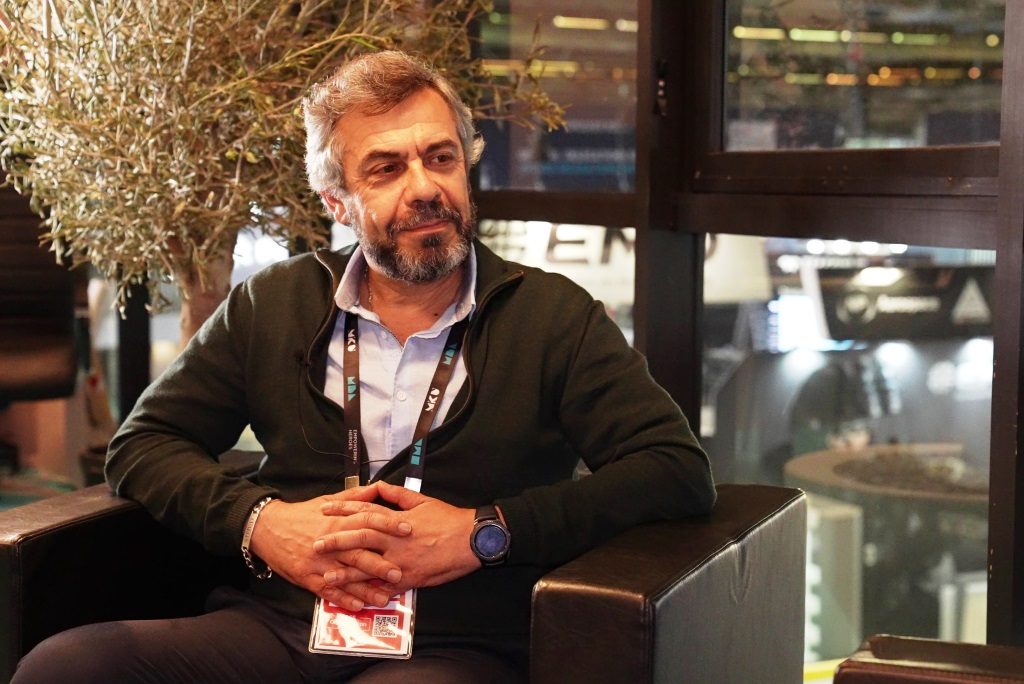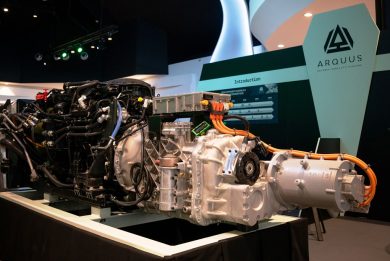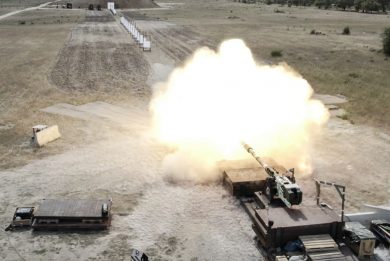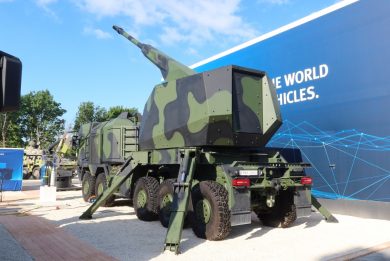
Record number of participants and new trends: the Eurosatory CEO analysis
We meet Maj.Gen. (ret) Charles Beaudouin, the COGES CEO and thus the organiser of Eurosatory, in his office from where it is possible to dominate Hall 6, where hundreds of people are at work to make sure that everything will be perfectly set when at 9 o’ clock on Monday, June 13th the doors will be opened to professional visitors.
A former French Army Cavalry officer, Charles Beaudouin left the service a few years ago in the position of Deputy Chief of Staff Plans and Programmes, having therefore been for some years the man in charge of the Army future programmes.
His first as the Eurosatory boss comes after four years interval, as the previous edition did not took place
“Let’s not forget that the 2020 exhibition was cancelled due to the pandemic. We started immediately preparing the 2022 edition in an uncertain climate due to the ups and downs of the COVID-19, and today Eurosatory presents itself as a record edition, with a number of exhibitors similar to that of 2018 which was a record year with 1,800 presences on the floor. The exhibitions that took place in the recent past saw the number of participants reduced by 30-40%, but the fact that we do not have in Europe any constraint linked to the pandemic favours the presence of a much higher number of attendants. We expect 15-20% more visitors, both in terms of official delegations and experts,” Charles Beaudouin tells EDR On-Line.
The informal meeting of Heads of State and Government that took place on March 11-12 in underlined that European defence assets must be increased, thanks to a major effort, which also highlighted the issue of the European technological and industrial defence base, which sees a strong internal competition but is also marked by major gaps in some areas. “Europe must organise itself creating synergies within its defence base, and this is probably a historical chance to do it. No European country has a national market that ensures profitability without exporting, so Europe can either become a platform where needs are put together to generate big serial numbers for armoured vehicles and other types of equipment, thanks to a strong common domestic market, or continue with competition among national industries, and in the end buy equipment from other continents,” Charles Beaudouin says, stressing the importance of a common European defence industry. Today Europe depends very much from the United States for its defence, and should the US turn its eyes somewhere else in a decade or so, Europe will be unable to defend itself. “To do so Europe must become a very strong NATO pillar and, should in the future NATO disappear, this pillar would remain insurance for European countries.”
The focus of defence exhibitions has also shifted considerably from a showcase aimed at end users to a turning platform that favours contacts among industries. “Today on the Eurosatory premises we have two major types of clients. The first one is represented by institutional presences, we have 250 official delegations, a marginal increase compared to 2018, representing over 100 countries, with Ministries, Chiefs of Staff, Chiefs of Procurement, who come to see the state of the art in defence, to feel the trends in the defence industry world that first tier countries must follow if they do not want to drag behind, and the same applies to the security domain. On the other hand these trends allow industries to compare themselves. We have slightly more than one third French exhibitors on the show; confronting them with around two thirds of exhibitors coming from other countries is, from my standpoint, a very healthy element, as this allows not only to compare products but also brings to some alliances among exhibitors,” the Eurosatory CEO tells EDR On-Line. He also underlines that, looking forward, we must think of big numbers, as digital systems are expensive and become old in a matter of 12-18 months, so both acquisition and ownership costs are high, which is a challenge for nations. “Digital systems must increase their performances but decrease their cost, in order to allow armies to get back to mass, so it is clear that the future is in the alliance among industries, within Europe but also with other continents. And anyway, it is impossible to seek export without alliances with industries in the targeted countries,” Charles Beaudouin says, adding that “having a defence industrial base is for a State a sort of soft power, the demonstration that it is capable to build the most complex land, air and naval systems, in order to ensure its own defence.”
Talking about trends, the comeback of high intensity conflicts, which was put in a lesser priority in the past decades, when armies adapted themselves to the missions they were called to carry out, without fully abandoning high intensity but clearly investing more resources on asymmetric issues. “The revival of the high intensity is well shown at this year edition by the comeback of heavy armoured vehicles, we have 200 of them on the Villepinte premises, and most of them highly protected. Long range surface-to-surface artillery assets as well as air defence systems are also at stake. Beside those you find new trends: it is obvious that armed drones are now accepted widely, after their use in a number of conflicts, in Syria, in Nagorno-Karabakh and last but not least in Ukraine. The drone has gone from being a key player to become a game changer, as it makes the battlefield transparent, it cancelled what used to be the key for success of all armies, surprise. We can say that for the first time since 1945, Western European soldiers look at the sky with worry, as danger comes from the sky, not necessarily from fixed or rotary wing aircraft, which can be neutralised relatively easily, but from drones that are difficult not only to detect, but which will also generate damages indirectly, for example getting target grids and providing them to artillery assets, or directly, as in the case of loitering munitions.” Gen. Beaudouin says.
This leads to counter-drone issues. “In the early 2020’s C-UAS is what C-IED was in the early 2000’s. Our armies had to adapt very quickly; massive use of IEDs started in 2003 in the Gulf, and armoured vehicles had always be designed mostly to counter ballistic threats, as engineer units were tasked t clear the field ahead of them. The appearance of radio-controlled IEDs allowed the opponent to choose the vehicle he will destroy in the convoy, so each vehicle must be protected. French Army Scorpion vehicles are directly issued from the experience acquired in Afghanistan, and this is the reason why they are bigger, taller and have a native protection against IEDs and mines. The war in Ukraine has shown that we must find a solution to neutralise drones, although it is clear that there will never be an absolute solution due to the continuous technology advance. Since the early 1990s we enjoyed 30 years of operational comfort, during which our armies had total air superiority and overwhelming fire. Today it is different, IEDs have already shown that to counter some threats we need very expensive systems, such as ground penetrating radars or over-protected vehicles; fighting against drones is a complicated issue as they are small, you need a radar to detect them, so we night end up with nearly one radar per vehicle or with dedicated escort vehicles, and detecting them is not sufficient, we must destroy them, which is not easy task, so we combine together jamming, high power lasers, up to kinetic effectors, all this with no 100% guarantee. To all this we must add the incoming swarm issue, which will saturate defences. Drones will not allow necessarily winning a war, but they might impede us from winning it.”
Switching to the cyber issue and to that of counter- and counter-counter measures the Eurosatory CEO says, “Counter-cyber means maintaining navigation and communication capacities even under cyber or EW jamming attacks, and this is of key importance for soldiers who do not have much time to train for operating in degraded mode.” And bad training in degraded mode can be one of the reasons of the high attrition among Russian units in Ukraine.
Stocks of ammunition and spares might also prove to be a critical item for western armies, as tight budgets often limited acquisitions. “Without budget you will not have stocks for enduring war, as war devours ammunition and spares, and secondly it will impede training,” Charles Beaudouin underlines, citing a French report stating that a Leclerc crew in 2022 will have only 60 hours training versus the planned 115 hours. “This crew cannot be considered operational, it is impossible: or it can be considered operational for stability operations, but definitely not for a high intensity conflict,” he adds.
“Another issue on stage is the environment, and armies have to start thinking about hybrid propulsion. I am personally a hybrid propulsion fan, and I consider we must develop it now, without further delays. Not only to reduce pollution but for having increased operational capacities, as it allows a final silent approach in the vicinity of the enemy, by a right coupling of the thermal engine and the electric motor we can obtain a boost effect to get out from difficult tactical situations, it provides redundancy in case one of the two power units is hit by enemy fire allowing to move to a safer position, and it would also ensure a much longer silent watch capacity,” Charles Beaudouin points out. As a former French Army programmes responsible he gives a concrete example: “In 2025 the French Army will get a hybrid prototype of the Griffon 6×6 that will, and from my standpoint I thing that the future armoured vehicle that will replace the VBL, known as the VBAE, should also be a hybrid vehicle and possibly also an optionally piloted one,” he concludes.
See you next Friday Sir, to draw the first conclusions of the five days of exhibition.
Photo courtesy P. Dupont



